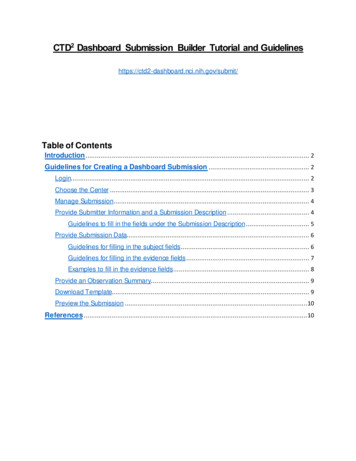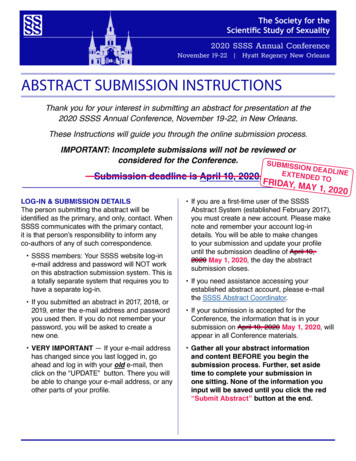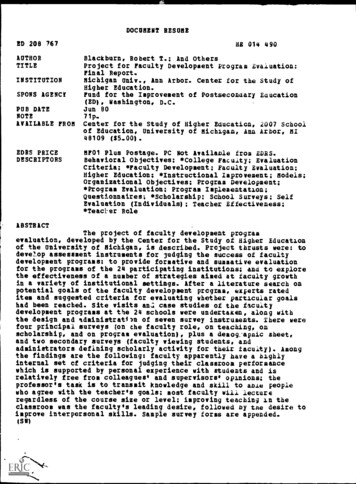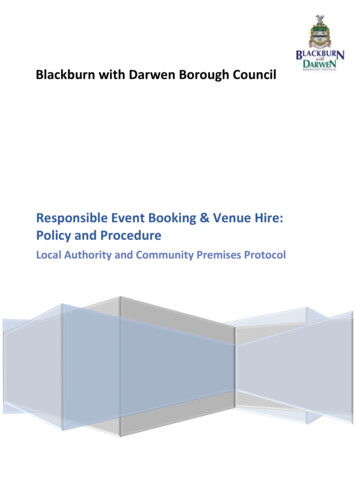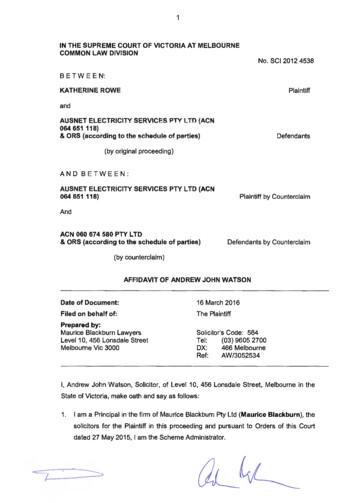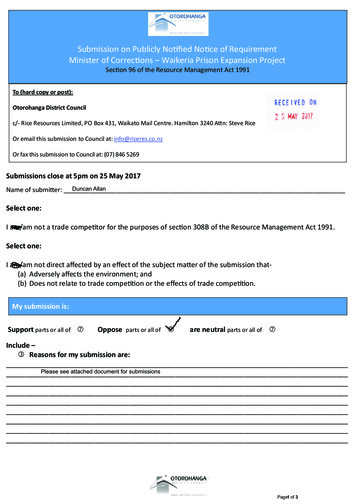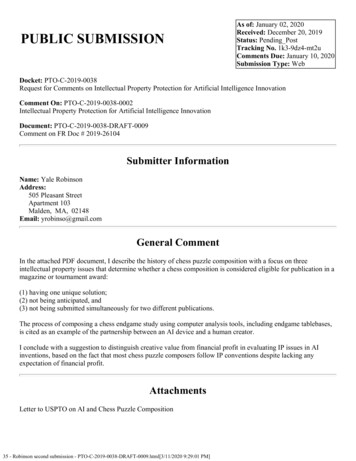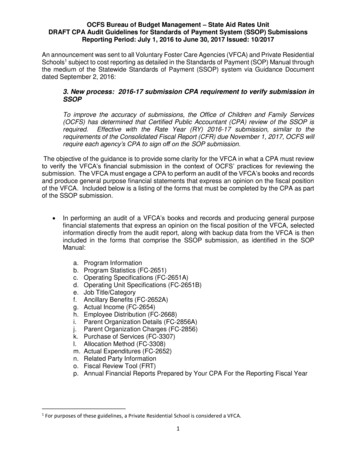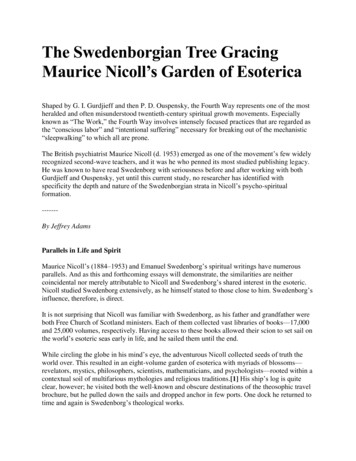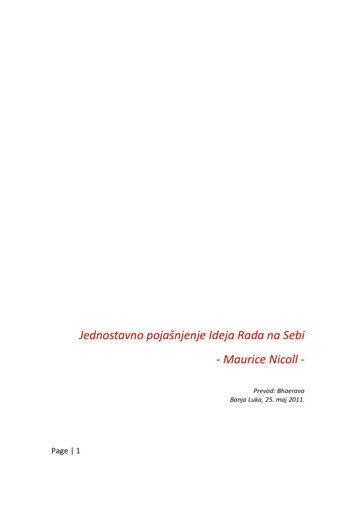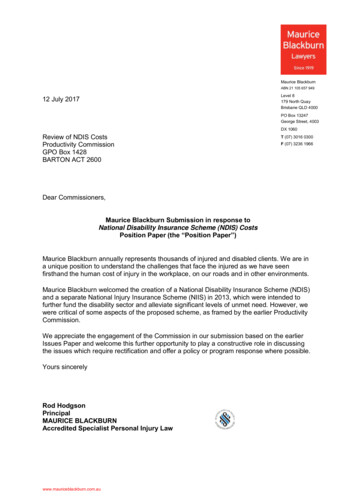
Transcription
Maurice BlackburnABN 21 105 657 949Level 8179 North QuayBrisbane QLD 400012 July 2017PO Box 13247George Street, 4003DX 1060Review of NDIS CostsProductivity CommissionGPO Box 1428BARTON ACT 2600T (07) 3016 0300F (07) 3236 1966Dear Commissioners,Maurice Blackburn Submission in response toNational Disability Insurance Scheme (NDIS) CostsPosition Paper (the “Position Paper”)Maurice Blackburn annually represents thousands of injured and disabled clients. We are ina unique position to understand the challenges that face the injured as we have seenfirsthand the human cost of injury in the workplace, on our roads and in other environments.Maurice Blackburn welcomed the creation of a National Disability Insurance Scheme (NDIS)and a separate National Injury Insurance Scheme (NIIS) in 2013, which were intended tofurther fund the disability sector and alleviate significant levels of unmet need. However, wewere critical of some aspects of the proposed scheme, as framed by the earlier ProductivityCommission.We appreciate the engagement of the Commission in our submission based on the earlierIssues Paper and welcome this further opportunity to play a constructive role in discussingthe issues which require rectification and offer a policy or program response where possible.Yours sincerelyRod HodgsonPrincipalMAURICE BLACKBURNAccredited Specialist Personal Injury Lawwww.mauriceblackburn.com.au
Submission to theProductivity Commissionin response to theNational DisabilityInsurance Scheme CostsPosition PaperJuly 2017
Maurice Blackburn submission to the Productivity Commission – July 2017About Maurice BlackburnMaurice Blackburn Pty Ltd is a plaintiff law firm with 32 permanent offices and 29 visitingoffices throughout all mainland States and Territories. The firm specialises in personalinjuries, medical negligence, employment and industrial law, dust diseases, superannuation,negligent financial and other advice, and consumer and commercial class actions.Maurice Blackburn employs over 1100 staff, including approximately 330 lawyers whoprovide advice and assistance to thousands of clients each year. The advice services areoften provided free of charge as it is firm policy in many areas to give the first consultation forfree. The firm also has a substantial social justice practice.General commentsConsistent with our previous public engagement on the rollout of the National DisabilityInsurance Scheme (the NDIS), our comments in response to the Position Paper are madelargely in sorrow rather than in anger.The success of the NDIS and its accompanying costs and policy frameworks is critical to thedignity and wellbeing of hundreds of thousands of our fellow citizens. More specifically, it iscentral to the ongoing interest of many of our current and former clients.Every day we work with Australians who have suffered severe and catastrophic injuries,assisting them to access justice, compensation and support as they attempt to rebuild theirlives. We assist them in navigating the law, social insurance schemes and private sectorinsurance. We engage with their families, friends and carers as they rally to assist our client.Our comments that go beyond sorrow are based on our passion and commitment to thesepeople and the frustrations that they have lived as the NDIS has been rolled out.Our long engagement in the scheme’s design trial sites and rollout has informed ourunderstanding of the scheme. We know that the NDIS can make a significant difference toour current and former clients, but there are real challenges ahead.The first step in meeting these challenges for the National Disability Insurance Agency(NDIA) and particularly its leadership is to be accountable for the failures that have occurred.We believe this accountability needs to include an apology.For instance, we were shocked to read of the Alzheimer’s Australia submission that set outthe experience of those with neurodegenerative diseases known to the organisation:-Of Annie who felt rushed by the over the phone planning session and she felt theassessor did not get a clear indication of her needs.Or when Annie first applied for disability support that even though she had adegenerative neurological condition she was “not disabled enough”.A person with Multiple Sclerosis was asked at a planning meeting “How long will MSlast?”, orA person with MS with only head movement was asked at their planning meeting ifthey would be able to hang out their own washing.This is consistent with the experience of our clients and the organisations we work with; andit is clear there are significant system and workforce development failures in evidence.Page 1
Maurice Blackburn submission to the Productivity Commission – July 2017Of course these issues around rollout and workforce and the development of participantplans were not some recent development, and they have previously been foreseen. Theyshould have been mitigated by the NDIA leadership.The Capability Review of January 2014 stated:Sector capacity building and workforce strategy: The Productivity Commission highlightedthe need to ensure the capacity of the sector to adapt to the NDIS was prioritised as theirbusiness models would need to transform for a competitive market. In addition, theProductivity Commission recommended the development of a workforce strategy to plan fora dramatic increase in workers required to deliver services under the NDIS. These planswere to be developed from June 2013 to July 2014. While these matters are beingaddressed, the focus on operations and a lack of permanent National Office staff hashindered the capacity of the Agency to genuinely prioritise these tasks. It has recentlyoutsourced the scoping of a workforce strategy.The inability to undertake this preparatory work has become a major pressure point for theAgency as it attempts to build its capability. The current plan is to complete 93 per cent of the eligibility assessments and activate almost300,000 participants over a three year period commencing 2017-18. This mammoth increasein activity will put huge pressures on the available workforce in the sector, let alone the1Agency. A realistic reassessment of these plans should be done sooner rather than later.The NDIA response to the Review in March 2014 was silent on these specific matters.This was in keeping with the previous approach by the NDIA leadership. Their mantra overthe past four years has been on track and on budget:“Work is already underway on this aspect of Scheme implementation and I am confident thatit will be put in place so that the NDIS achieves its goals.” NDIA Chair, Bruce Bonyhady,2June 2013“Now, as we celebrate the first anniversary of the Scheme, the achievements are groundbreaking The NDIS is laying the foundations for success With the first full year of the trialphase for the Scheme now completed, we are well positioned for planning the3implementation of the full scheme.” Bonyhady, July 2014“The rollout of the NDIS is currently on time and on budget – with a satisfaction rating of4more than 90 per cent from participants.” Bonyhady, October 2015“The rollout of the Scheme is, therefore, on time The NDIS is also on budget.” Bonyhady,5September 2016But as clients and groups that support the clients are emerging through this process to becritical of the client experience, the NDIA is now choosing 2017 to deflect accountability byhiding behind the rollout timetable. To explain all of their failures by pointing to a decisionmade in December 2012 by the then Prime Minister and State Premiers is a deflection fromfailures in design, assessment, planning, workforce development and transparency.The appropriate response would have been to acknowledge the failures, make amends withclients and to develop the response, working in collaboration with the Australian Governmentand the appropriate external advisers.Page 2
Maurice Blackburn submission to the Productivity Commission – July 2017The experience of our clients and community partnersWe engage with the NDIS in three ways: Through direct engagement on behalf of our clients Through the experience of service providers who work with our clients (forexample in allied health), and Through the experience of other organisations we work with, typically healthadvocacy and support organisations.The feedback we have received in relation to the NDIS and the NDIA and planners is broadlyconsistent with the observations and recommendations of the position paper.Three key themes have emerged in this feedback.Firstly, there have been consistent and shocking failures in planning processes.The phone consultations have been a debacle and they have led to dissatisfaction, disputesand unnecessary duplication. The use of reference packages has undermined confidence inthe process, and specifically undermined notions of choice and client-centricity.The NDIA submission to this process describes the use of reference packages as “relativelyblunt” but then states that they will continue to form the basis of quality assessment andinitial plans of participants. The vast majority of people with disabilities have complex needs.The processes for plan development is not respectful of that reality. Holistic and bespokeplans are instead being replaced by minimalist, cookie-cutter versions. The NDIS staff arecompelled to apply this model.Participants’ “choice and control”, a mantra for the NDIS for years, is set aside. This ishardly surprising: the NDIA achieving numerical targets, keeping a lid on the package costs,and deficient internal workforce planning, all combine to ensure that the NDIA controls theplanning process, and that participants’ choice is largely illusory.The lack of training and support for staff undertaking planning has also undermined theprocess. The experiences articulated by the Alzheimer’s Australia submission are consistentwith the feedback we have received regarding inappropriate time, knowledge and sensitivityto the conditions of the participant.We also have concern regarding transparency. There are multiple aspects to this.Firstly, the consequences for those Australians with a disability outside the NDIS areunknown. Services are changing due to the NDIS but for those outside it is a reduction inservices.The review and appeals regime is poorly understood and difficult to access. The NDIS hasfailed to properly educate participants about the process and creates barriers by not followingtheir own requirements, for example, by not providing reviewable decisions in writing or notinforming participants that a particular decision is reviewable. Further, funding for advocacyis still not adequate. In any new government insurance scheme, it is critical participants havea voice in advocating for change and retentions of aspects of the NDIS.While we do not know Ya’el Frish from the Council of Social Services NSW, they veryarticulately explained the shortcomings of the current arrangements in May 2015:Page 3
Maurice Blackburn submission to the Productivity Commission – July 2017At COAG, Australia's disability ministers recently agreed that some support relatedto individual advocacy would be funded by the NDIS on a "user-pays" basis.I will be eligible for an NDIS funding package to cover my personal care supportsbut is it right that I am asked to choose between a daily shower and money foradvocacy, "just in case" something goes wrong?The need for advocacy will become more acute as people with disability experienceincreased choice and control under the NDIS and the best way to do this is for stateand commonwealth governments to fund these services outside the NDIS.6Thirdly, there is next to no legal support available for participants to challenge the NDIA’sdefinition of “reasonable and necessary supports”. Again, in any new system the decisionsmade should be tested by advocacy and adjudication. But at present, the access to justice isvery limited to participants despite the fact a positive decision regarding these supports, insome instances, may make a significant difference to their quality of life. From the firstProductivity Commission NDIS report in 2011, we can clearly discern a “participants’representatives (including lawyers) out; the agency knows best” ethos.In a related issue, there is currently no timeframe in which the NDIA has to respond to aformal request for internal review. The NDIA states they have to respond as soon aspracticable – which is in stark contrast to the timeframes in which the client has to make therequest.This creates a number of difficulties. Firstly, it creates enormous uncertainty for participants.It also leads to poor outcomes because, as we understand, the plans are suspended while areview is on foot. Finally, it undermines the appeals process because, as it has beendescribed to us, the NDIA can defer the review until the plan expires or comes up to itsscheduled review. The Authority then issues a new plan and if the support still is not funded,the participant has to start the review process again.Finally, through our extensive network of offices in regional and rural communities, we arebecoming increasingly aware of shortcomings in thin markets. We are seeing wellestablished service providers closing or merging, taking away community connection. TheNDIA needs to be up front about the differences in these markets and manage themdifferently. The pretence of all markets being the same cannot be sustained. This is afunction of the NDIA’s aim to be the price-setter for the provision of disability servicesnationally. That aim is unrealistic.Response to draft recommendations, findings and information requestsDRAFT FINDING 2.1The scale and pace of the National Disability Insurance Scheme (NDIS) rollout to full schemeis highly ambitious. It risks the National Disability Insurance Agency (NDIA) not being able toimplement the NDIS as intended and it poses risks to the financial sustainability of thescheme. The NDIA is cognisant of these risks.Response:Our previous submission stated that a prudent approach would be to consider a slower rollout schedule to help minimise those risks. Given the cross-jurisdictional complexity, anextended phasing in would need to be re-negotiated on the basis of independent assessmentof the preparedness of each jurisdiction and associated risks. This may involve a completePage 4
Maurice Blackburn submission to the Productivity Commission – July 2017cessation of the rollout on a regional basis for a period to enable the remedial work to beundertaken.Aside from managing financial risks, a roll-out over an extended period would avoidsignificant frustration and distress for those living with disabilities and their families, and allowlessons learned from the early results to be incorporated into the scheme’s final design.DRAFT FINDING 2.4Early evidence suggests that the National Disability Insurance Scheme is improving the livesof many participants and their families and carers. Many participants report more choice andcontrol over the supports they receive and an increase in the amount of support provided.However, not all participants are benefiting from the scheme. Participants with psychosocialdisability, and those who struggle to navigate the scheme, are most at risk of experiencingpoor outcomes.In addition to the feedback provided earlier in this submission, we alert the ProductivityCommission to the complexities in navigating the scheme, even for the most sophisticateduser. We refer specifically to the delays in securing calculation of the CompensationReduction Amount - “CRA” for a client of our firm, and a potential or ongoing NDISparticipant.These arrangements recognise compensation that has been received through a legalprocess by a scheme participant. It helps reduce the NDIS’ liabilities and secure its financialposition.Thousands of personal injury claims are determined each year for people who are likely to beeligible to receive funded NDIS benefits. However, before these claims can be settled, thelegal representatives need an estimate of the potential repayment to the NDIS for pastsupports, and an estimate of the likely CRA. Without those estimates, the participant’s legalrepresentatives cannot advise their client on the impact of any settlement on their NDISentitlements.Through the first half of early 2017 we experienced significant delays in obtaining theinformation from the NDIA, preventing the timely settlements of claims.For instance, we first contacted the NDIA in January 2016 on behalf of an adult client toconfirm their CRA. We are yet to confirm a CRA in this case. This has followed a situationwhere it took over 12 months to get an estimate of the repayment for past benefits for thisclient. Then, months later, we were told the actual repayment was over four times theprevious estimate.This is a deeply frustrating set of circumstances for our client given this is effectively astraightforward actuarial calculation by the NDIA officer and a subsequent formalcommunication.This is not isolated. We understand that the backlog of CRA matters is approximately 12months.It is clearly in participants’ interests that the NDIS develop a consistent process for dealingwith these requests in a timely and efficient way because it allows them to resolve theircompensation claims and properly prepare for their future care needs. This is also in theinterest of the NDIS as it allows legal representatives to inform our clients about the NDISand properly manage expectations. It also means that repayments from compensation canbe processed, mitigating the need for the NDIA to recover the money from clients directly.Page 5
Maurice Blackburn submission to the Productivity Commission – July 2017INFORMATION REQUEST 4.1Is the National Disability Insurance Scheme Act 2013 (Cwlth) sufficiently clear about how orwhether the ‘reasonable and necessary’ criterion should be applied? Is there sufficient clarityaround how the section 34(1) criteria relate to the consideration of what is reasonable andnecessary?Is better legislative direction about what is reasonable and necessary required? If so, whatimprovements should be made? What would be the implications of these changes for thefinancial sustainability of the scheme?Response:Our strong view is that the NDIA needs to actively support the testing and further explorationof all aspects of the definition of “reasonable and necessary” supports by clients through theAAT and the Federal Court of Australia.One aspect of this is to better fund advocacy organisations; another is to make a contributiontowards legal costs to provide better access to justice. The absence of entitlement to legalcosts for participants’ successful appeals to the AAT exacerbates a profound powerimbalance between participants and the NDIA.Change is consistent with making the NDIA leadership accountable for its actions and theapplication of “reasonable and necessary” being more transparent. Encouraging andsupporting external review of NDIA decisions and the scheme’s operation will also increasepublic confidence.DRAFT RECOMMENDATION 4.1The National Disability Insurance Agency should: implement a process for allowing minor amendments or adjustments to plans withouttriggering a full plan review review its protocols relating to how phone planning is used provide clear, comprehensive and up to date information about how the planningprocess operates, what to expect during the planning process, and participants’ rightsand options ensure that Local Area Coordinators are on the ground six months before the scheme isrolled out in an area and are engaging in pre planning with participants.DRAFT RECOMMENDATION 4.2The National Disability Insurance Agency should ensure that planners have a generalunderstanding about different types of disability. For types of disability that require specialistknowledge (such as psychosocial disability), there should be specialised planning teamsand/or more use of industry knowledge and expertise.Response:Based on our experience, we strongly agree with these recommendations. The situation todate, based on anecdotal and empirical feedback, is concerning.The most disappointing aspect of this is that the NDIA was strongly encouraged by the 2014Capability Review to consider the pressures of this activity.Page 6
Maurice Blackburn submission to the Productivity Commission – July 2017The discussion paper’s summary of the National Institute of Labour Studies evaluation thatsome are experiencing poorer outcomes under the NDIS, many are experiencing difficultyaccessing supports and a significant proportion feel they have less control and choice isdeeply concerning.The discussion paper noted strong dissatisfaction with phone planning, consistent withfeedback we have received. We congratulate the Commission for making the very clear pointthat phone planning is not appropriate for a wide range of participants for reasons that shouldnot require explanation.Something is clearly fundamentally wrong with the design and operation of the planningprocess and as such, significant change is required.DRAFT RECOMMENDATION 5.2The Australian, State and Territory Governments should make public their approach toproviding continuity of support and the services they intend to provide to people (includingthe value of supports and number of people covered), beyond supports provided through theNational Disability Insurance Scheme. These arrangements for services should be reflectedin the upcoming bilateral agreements for the full scheme.The National Disability Insurance Agency should report, in its quarterly COAG DisabilityReform Council report, on boundary issues as they are playing out on the ground, includingidentifying service gaps and actions to address barriers to accessing disability andmainstream services for people with disability.Response:The experience of organisations we work with is consistent with the observations detailed inthe position paper on page 30 onwards. Specifically, that there is significant concern that asprograms are rolled into the NDIS, those using these existing services – who are not eligiblefor the NDIS - may no longer receive support. Mental health was provided as a specificexample.We have had ongoing engagement with key unions who covered these services and theyhold significant concerns consistent with these observations and are seeing these concernsmanifest as a real withdrawal of services.INFORMATION REQUEST 5.1The Commission is seeking feedback on a mechanism to ensure that the States andTerritories bear the cost of participants who were intended to be covered by the NationalInjury Insurance Scheme.Response:The Commission has, unfortunately, failed to interrogate the consequences of the NIIS as itwas envisioned by the original Productivity Commission report. In essence, a New Zealandlike scheme was advocated. The profound economic folly of such a scheme has been fullyarticulated in our previous submissions. There are no obvious or natural funding streams,nor administrative infrastructure for any further expansion of the NIIS.We offer four observations that are critical in considering any further potential mechanism.Firstly, COAG decided to not proceed with the Medical Treatment stream of the NIIS at itsmeeting on June 6, 2017. It also requested Treasurers, in consultation with the DisabilityReform Council, for advice on a general accident stream.Page 7
Maurice Blackburn submission to the Productivity Commission – July 2017Secondly, notwithstanding commitments made with South Australia, the full scheme bilateralagreements do not require States and Territories to meet specific benchmarks beyond roadand workplace accidents. As such, there is no obligation for States and Territories to gobeyond those two pillars unless the Commonwealth wishes to reopen these bilateralagreements. Given the complexity of Federal-State relations, this is unlikely.Thirdly, the NDIS is a safety net scheme that is committed to ensuring there is a last resortprovision of services for anyone eligible for the scheme.For those who have suffered a catastrophic injury in a “general” accident, for example, theywill be able to access the NDIS on an ongoing basis, potentially including access totherapeutic services. As this represents the majority of their remaining lives, the currentfunding for the NDIS will be providing support for this relatively small number of clients.Finally, any general accident pillar lacks scale, funding and wide demand.Those who suffer catastrophic “general” accidents are already accessing Medicare supportservices in the immediate aftermath of their accident through the hospital system.We also believe that the number of Australians in the “medical treatment” pillar who wouldnot otherwise be supported through existing insurance and legal processes is only a fewpeople each year.In relation to funding such a pillar, State Governments are highly sensitive to any increase inlocal government rates and some States have even taken the step of legislated caps onrates. As such, they will not consider a new increase to rates.If the priority is to create structures to create incentives to minimise risk, a more effectivemechanism will be through engagement with the likes of ALGA and LGPro.As such, to presume that the States and Territories will willingly reopen a negotiatedagreement to take over the financial and operational responsibility for supporting this smallgroup of people who would be under the fourth pillar is flawed.In relation to a potential mechanism, the missing gaps in the system are sub-acuterehabilitation services for those who suffer catastrophic injuries away from roads andworkplaces, and unable to access existing medical insurance and legal regimes. These arenot currently funded via the NDIS.We assert that based on insurance principles, the NDIS should be meeting these initialrehabilitation services needs post-hospital and prior to stabilisation of their disability andentry into the NDIS’ ongoing services.We believe that such an approach will save money in the long run by improving outcomes, isthe next best option given the COAG and negotiation positions, and reinforces the principlesof the NDIS approach.Time, resources and intellectual efforts ought first to be focused upon getting the NDIS right;before any reconsideration of the NIIS occurs.DRAFT FINDING 6.1In a market based model for disability supports, thin markets will persist for some groups,including some participants:Page 8
Maurice Blackburn submission to the Productivity Commission – July 2017 living in outer regional, remote and very remote areas with complex, specialised or high intensity needs, or very challenging behaviours from culturally and linguistically diverse backgrounds who are Aboriginal and Torres Strait Islander Australians who have an acute and immediate need (crisis care and accommodation).In the absence of effective government intervention, such market failure is likely to result ingreater shortages, less competition and poorer participant outcomes.ResponseAs reiterated earlier in this submission, through our network of regional offices and ourongoing relationships with local service providers, we believe the shifting structure of themarket plus the existing thin markets in regional and rural communities may require strongand specific intervention by the NDIA.We believe that the options being considered by the Commission, including leveragingestablished community organisations, using hub and spoke models and relying on othermainstream providers are all worthwhile considerations. But it needs to be done on the basisthat staff are paid appropriately, engaged appropriately and that market rates can varysignificantly between communities.DRAFT RECOMMENDATION 7.1The roles and responsibilities of different parties to develop the National Disability InsuranceScheme workforce should be clarified and made public. State and Territory Governments should make use of their previous experience inadministering disability care and support services to play a greater role in identifyingworkforce gaps and remedies tailored to their jurisdiction. The Australian Government should retain oversight of workforce development,including how tertiary education, immigration and aged care policy interact and affectthe development of the workforce. In doing so, the Australian Government should payparticular attention to immigration policy to mitigate workforce shortages over thetransition period. The National Disability Insurance Agency should provide State and TerritoryGovernments with data held by the Agency to enable those jurisdictions to makeeffective workforce development policy. Providers of disability supports should have access to a clear and consistentmechanism to alert those tasked with market development about emerging andpersistent workforce gaps.This is a critical issue that was a key theme of our initial submission.In a broad sense, this is not just an issue for clients and their carers and families; it is also acritical focus to protect employees.We believe there is a danger of precarious employment, the emergence of piece rates andsham contracting and a specific danger of injury to participants and disability workers throughnon-compliance with Occupational Health and Safety laws and regulations.DRAFT RECOMMENDATION 7.2The National Disability Insurance Agency should publish more detailed market positionstatements on an annual basis. These should include information on the number ofparticipants, committed supports, existing providers and previous actual expenditure by localgovernment area.Page 9
Maurice Blackburn submission to the Productivity Commission – July 2017The Australian Government should provide funding to the Australian Bureau of Statistics toregularly collect and publish information on the qualifications, age, hours of work andincomes of those working in disability care roles, including allied health
Maurice Blackburn ABN 21 105 657 949 Level 8 179 North Quay Brisbane QLD 4000 PO Box 13247 George Street, 4003 DX 1060 T (07) 3016 0300 F (07) 3236 1966 www.mauriceblackburn.com.au . 12 July 2017 . Review of NDIS Costs . Productivity Commission . GPO Box 1428 . BARTON ACT 2600 . Dear Commissioners, Maurice Blackburn Submission in response to

